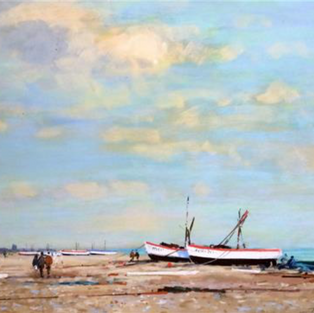Travelling around Britain through paintings
- emily3193
- Nov 11, 2020
- 3 min read
Never has there been a year in which we have been more reminded about ‘place’ than in this one just passing. We’ve been forced to recognise our place as part of the wider world where a pandemic doesn’t just stay in the East, we’ve had to examine our place in our local communities and have been obliged to make selfless decisions to protect the health of others and, most importantly we’ve been forced to stay put and so examine the place we call our immediate home. How wonderful then is the power of art to transport us from our temporarily narrowed vistas and with the stroke of a brush, remind us of the country that continues to exist beyond.
Though a small island overcrowded and heavily marked by man the United Kingdom is blessed with an old landscape where time and natural earth systems have had a far greater impact on its geography than humans over the last thousand years. From wild coastal waters to the pastoral tranquillity of its interior and now the ever-encroaching urban landscapes, generations of artists have found a constant source of inspiration here.
This is a year then, that paintings can take us on a whistle stop tour of this our small Island.
In ‘A Boat on the Foreshore’ Donald Hamilton Frasers semi abstract painting captures the space within the azure depths of the horizon where sky and sea meet near sandy spits. A simple lonely boat, marooned as it is on the beach, seems to epitomise the yearning of our island inhabitants to be either on or in the water. There is no such sense of solitude in James Longuevilles’ ‘Aldeburgh, Suffolk’ a painting which captures the busy industry of a beach filled people and boats being repaired. The iridescent glow of the clouds in a blustery sky contrasts with the muddy smudge of cold shingle and the wrapped-up people below. By contrast Peter Symonds uses a vivid palette to show tourists at play in ‘High Summer, North Cornwall’. The vantage point he chooses draws out shadows on the sand as the people like ants below, wade in the sunlit shallows and are dwarfed by the cliffs and endless ocean like a treasured holiday dream.
Moving inland ‘Easdale Tarn’ by Alfred De Breanski portrays that very British sort of weather which we see approaching across the lake and as it does, so it leaves behind holes in the clouds through which the sun illuminates and distorts the distant mountains. This is a landscape where time stands still, and the ancient panorama remains unchanged and man diminutive. In the gloaming domestic cattle paddle and a cottage roof appears in the distance but it is the empty and bright shores of the mountains opposite which draw our eye.
Harold Sutton Palmer with his depiction of ‘Evening on the Moor’ takes us upstream to the tributaries and streams that carve up our landscape. Whether swollen in winter or depicted as lazy rivers further downstream, the majesty of water inhabits so many of his landscapes. In this watercolour the bracken, scrub and skeletal trees have been temporarily tamed in the foreground of the painting. In the distance behind however the wilderness continues, settled and impenetrable and only the icy water cuts through it.
The bucolic view of Martin Taylors ‘Straw Bales’ gives the viewer a finely observed harvest scene in his home county of Northamptonshire. We can almost feel the sharp scratchy crunch of stubble underfoot and we can see each whisp of unruly straw restrained in the bales. Everything on the peripheries is lush and vigorous and the pallet of gold, green and blue is simple yet evocative. This cleanness of style belies the great intricacies of Martins work as he keenly observes each intertwined piece of vegetation or twig as in ‘Dark Wood’. The raw beauty of the tree stands on its own, it’s not about a sunny day but about every organic thing in front of Martin as he paints. He observes and walks us through a stark winters’ landscape.
Any tour of the United Kingdom through art would not be complete without representing the cityscapes of our country. ‘Early Spring, Parliament Hill, London’ by Peter Van Breda captures the contradiction man feels in becoming an increasingly urban animal. From this iconic London vista, the modern cityscape with notable landmarks is laid out below in hazy greys and blues. The people in the painting, however, have sought to observe the jumble of the city beyond from the respite of the green and blossom speckled space of the park .




















Comments